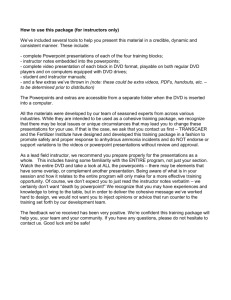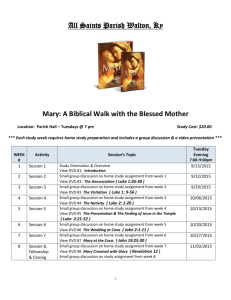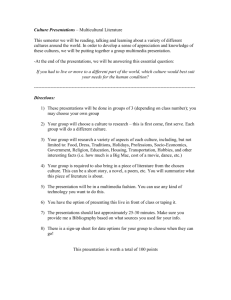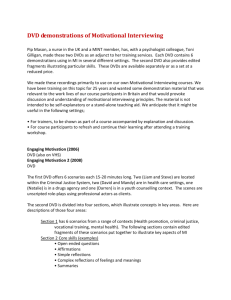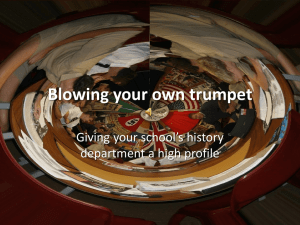Enhancing Teaching through Research as Professional Practice
advertisement
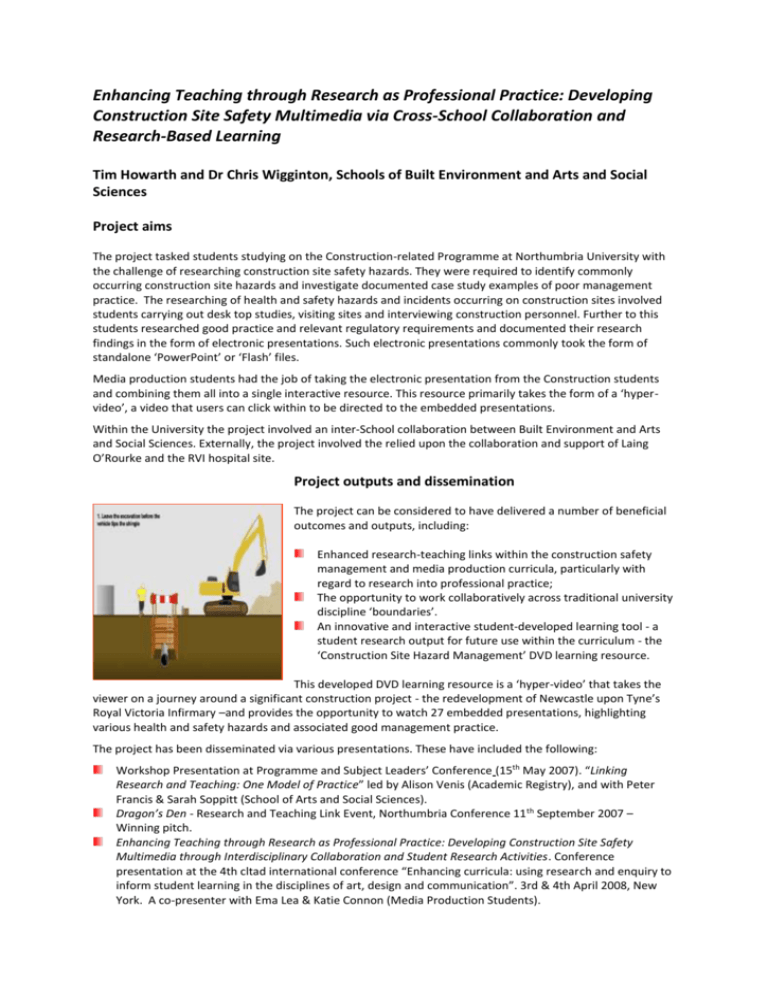
Enhancing Teaching through Research as Professional Practice: Developing Construction Site Safety Multimedia via Cross-School Collaboration and Research-Based Learning Tim Howarth and Dr Chris Wigginton, Schools of Built Environment and Arts and Social Sciences Project aims The project tasked students studying on the Construction-related Programme at Northumbria University with the challenge of researching construction site safety hazards. They were required to identify commonly occurring construction site hazards and investigate documented case study examples of poor management practice. The researching of health and safety hazards and incidents occurring on construction sites involved students carrying out desk top studies, visiting sites and interviewing construction personnel. Further to this students researched good practice and relevant regulatory requirements and documented their research findings in the form of electronic presentations. Such electronic presentations commonly took the form of standalone ‘PowerPoint’ or ‘Flash’ files. Media production students had the job of taking the electronic presentation from the Construction students and combining them all into a single interactive resource. This resource primarily takes the form of a ‘hypervideo’, a video that users can click within to be directed to the embedded presentations. Within the University the project involved an inter-School collaboration between Built Environment and Arts and Social Sciences. Externally, the project involved the relied upon the collaboration and support of Laing O’Rourke and the RVI hospital site. Project outputs and dissemination The project can be considered to have delivered a number of beneficial outcomes and outputs, including: Enhanced research-teaching links within the construction safety management and media production curricula, particularly with regard to research into professional practice; The opportunity to work collaboratively across traditional university discipline ‘boundaries’. An innovative and interactive student-developed learning tool - a student research output for future use within the curriculum - the ‘Construction Site Hazard Management’ DVD learning resource. This developed DVD learning resource is a ‘hyper-video’ that takes the viewer on a journey around a significant construction project - the redevelopment of Newcastle upon Tyne’s Royal Victoria Infirmary –and provides the opportunity to watch 27 embedded presentations, highlighting various health and safety hazards and associated good management practice. The project has been disseminated via various presentations. These have included the following: Workshop Presentation at Programme and Subject Leaders’ Conference (15th May 2007). “Linking Research and Teaching: One Model of Practice” led by Alison Venis (Academic Registry), and with Peter Francis & Sarah Soppitt (School of Arts and Social Sciences). Dragon’s Den - Research and Teaching Link Event, Northumbria Conference 11 th September 2007 – Winning pitch. Enhancing Teaching through Research as Professional Practice: Developing Construction Site Safety Multimedia through Interdisciplinary Collaboration and Student Research Activities. Conference presentation at the 4th cltad international conference “Enhancing curricula: using research and enquiry to inform student learning in the disciplines of art, design and communication”. 3rd & 4th April 2008, New York. A co-presenter with Ema Lea & Katie Connon (Media Production Students). Facets of Northumbria’s Research-Teaching Initiative (Group Symposium) & Enhancing Departmental and Institutional Practice in Research-Teaching Links (Workshop). A Northumbria University-wide event ‘Focus on Research Informed Teaching - Strategies to Enhance Research-Teaching Linkages’. 24th April 2008. A copresenter with Linda Allin, Lesley Fishwick, Liz McDowell, Nicola Reimann, Alison Venis (Northumbria University). Institution Strategies to Enhance Research-Teaching Linkages. Symposium and Workshop presentations at “The Teaching - Research Interface: Implications for Practice in HE and FE Conference”. Organised by ‘ESCalate’, The Higher Education Academy’s subject centre for Advanced Learning and Teaching in Education. Stirling Management Centre, University of Stirling. 29th and 30th April 2008. A co-presenter with Linda Allin, Lesley Fishwick, Nicola Reimann, Alison Venis (Northumbria University). Display of the project DVD learning resource at the Northumbria Conference September 2008. The availability of the project’s resultant DVD learning resource has been disseminated by the Higher Education Academy’s (HEA) Subject Centre for Education in the Built Environment (September 2008) http://www.cebe.heacademy.ac.uk/news/archievent.php?news=September%202008#508931 . The availability of the DVD has also been disseminated via ‘Construction Knowledge Exchange’ – a Government established Centre to support higher education institutions working with business and the wider community http://www.cke.org.uk/index.php?option=com_frontpage&Itemid=1 . To date, it has been requested and dispatched to over 50 FE and HE institutions with the UK – as an example student-developed and collaboratively produced construction site hazard management learning resource. Further to the project, Tim Howarth was invited to deliver a staff development workshop at Sheffield Hallam University - ‘A Workshop to share Inquiry-based learning approaches’ Wed 11th Feb 2009. An article about the project is to be published in Spring 2009 in CEBE’s ‘News Update’ publication (Issue 19 ISSN: 1471-0773) Project impact and evaluation The project engaged some 180 students in an inquiry-based research project over a period of 18 months. Since project completion and production of the DVD learning resource, some 175 Built Environment students have viewed the resource. Furthermore the resource has been requested by, and dispatch to, some 50 HE and FE institutions across the UK. Questionnaire feedback from student users of the resource has been very positive. The resource is perceived as being easy to use and has a number of commonly reported strengths – it’s easy to understand, enables self learning, provides an interesting approach to the topic, is portable, to list but a few – and no significant limitations. The positive feedback has not been limited to students engaged in the research process and to students using the develop DVD resource. Teaching colleagues, using the DVD learning resource, have commented favourably - one professor, external to Northumbria commented that the DVD learning resource “Is an excellent and innovative construction health and safety learning resource that supports a good depth and breadth of relevant study. The resource is innovative in terms of its learning and teaching approach to construction health and safety and is a very user friendly. I am not aware of a similar tool within this particular domain and welcome this novel approach. [Our] University intends, with permission, to use this resource with our students and part-time professional practitioners to enhance the study of health and safety. This learning tool will no doubt effectively support our on- and off-site delivery and will be particularly useful to students who are learning at a distance.” The developed DVD learning resource will continue to be used within Built Environment curriculum. Feedback will also continue to be requested from student utilizing the resource and from each ‘teacher’ recipient of the DVD learning resource. Whilst this collaborative project has now completed, the benefits of the project will be maintained through the continued deployment of inquiry-based learning within the construction programme Construction Programme students will review the content of the resource, suggest improvements and investigate the possibility of repeating the project with an on-line method of delivery, rather than via DVD. Lessons learnt The creation of a multimedia learning resource as a product of professionally-relevant student research must surely be considered to be a significant element of good practice emanating from this project. Here student research becomes a useable resource for future use within the curriculum. Furthermore the multimedia resource is itself an excellent example of an innovative resource created within the HE curriculum. It is worth noting also that no such interactive multimedia learning resource currently exists on the market for construction site safety hazard awareness and management. The project has enabled both formative and summative assessment of students to be undertaken within the context of professionally-relevant research project – a further good practice element. Many students view the assignment associated with this project as being about more than ‘just learning outcomes assessment’ and ‘passing the module’. The assignment has a very real and applicable professional context and delivers a tangible research output that could contribute to the learning of others (through the multimedia resource). This is commonly appreciated by the students and as such encourages them to raise their horizons with regard to the value of the assignment and its extended contribution beyond their own learning and their own grades. The inter-school nature of this collaborative project has also enabled staff of previously unconnected disciplines to engage, discuss and informally share both practice and further development ideas. This informal practice, enabled by the project, could be considered as contributing to ‘good staff development’. Contribution to culture change Presentations of the project have been made to support the dissemination and development of research and teaching link practice and culture at a number of Northumbria University events this year. The project will continue to be presented at national and international conferences out with the School, and to further promote the dimensions of the research and teaching link. This project has engaged student as ‘inquiry-based learners’. Students have actively undertaken research activity – to such an extent that the media production students can be said to have undertaken ‘research into practice’. This engagement is far removed from the ‘traditional model’ of the ‘research-led’ approach.

